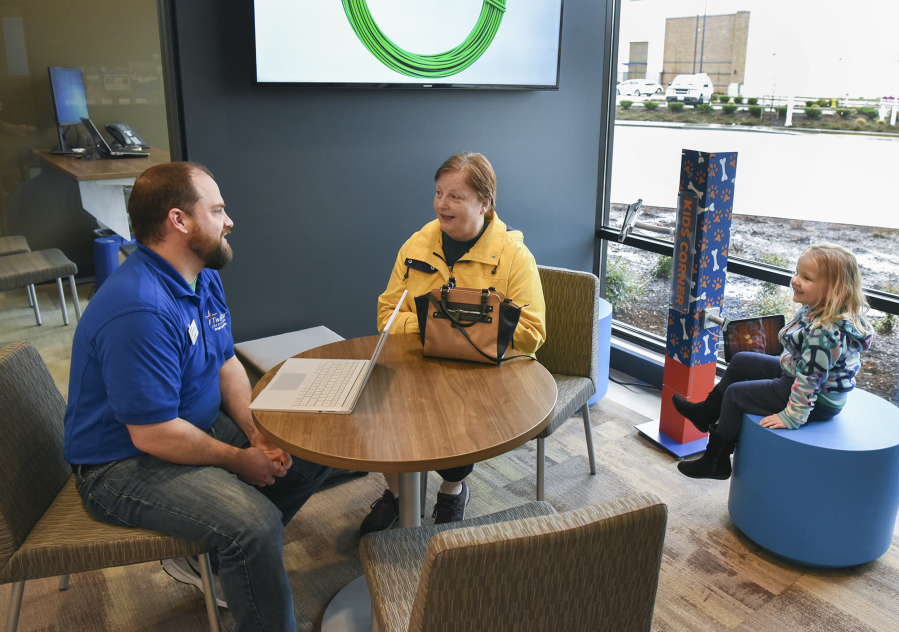Matt Devlin, chief marketing officer for TwinStar Credit Union, jokingly called its new Hazel Dell branch “the laboratory.”
A long, marble table dominates the lobby, in front of a pair of mounted flat-screen televisions. Tablet computers and mobile phones are plugged in on a nearby table and propped up for demos. The bank looks like a cousin of the Apple Store.
With smartphones and mobile banking cutting dramatically the number of visits to branches, financial institutions are trashing practices that made visiting feel like a chore.
“People want to come in if they have an issue, but they don’t want to come in for every issue,” said branch manager Jeff Tennant. “The only constant is change.”
Mobile banking is rising quickly. According to a March 2016 report from the Federal Reserve System, 43 percent of mobile phone owners with a bank account used phones to bank — up from 39 percent the year before.
Like TwinStar, banks and credit unions are changing along with their customers’ habits. Mobile banking has taken over many daily transactions, turning branches mostly into places to discuss bigger business, such as loans and retirement planning.
While there are people who visit branches to make deposits and withdrawals, Devlin said banks are becoming mostly places “for people who have questions,” he said.
Banks or cafes?
Verity Credit Union in Seattle recently opened two banks that mimic coffee shops, putting loan negotiations on cafe-style tables where one could imagine would-be novelists typing away.
Some banks fully embrace digital banking. Bank of America opened three entirely automated branches in New York City last month. Customers use ATMs and talk with employees via video conference if necessary.
“What we’ve seen in the last five to eight years has been a dramatic change in what people are expecting from their financial institution — whatever that might be,” said Bob Saunders, executive vice president of Momentum Inc., a planning and designing firm for financial institutions.
Speaking about a client who runs a credit union, Saunders said “His famous quote is: I want to convince my members they never have to come in (to the branch) at all.”
Smartphones first made it possible to check bank balances on the go. Today, a person can deposit a check by taking a photograph of it — if he or she doesn’t already have direct deposit.
With less foot traffic, banks have gotten smaller and amenities have become more important, Saunders said. Umpqua Bank, based in Portland, famously offers yoga classes at some of its locations.
“They say, I’m going to give you Wi-Fi access, a coffee machine, a white board,” for people to conduct meetings, he said.
TwinStar’s approach
TwinStar’s Hazel Dell branch, opened in January, strives to balance the tech influence and the personal touch. Tablet computers are set up in the corner for kids to play video games while parents talk with bankers.
Employees carry laptops and share office space. They act as both bank tellers and loan officers. They also spend time teaching new customers how to use mobile apps at the technology bar, a table where all sorts of devices can be used to demonstrate the credit union’s apps.
When people do enter a branch, financial institutions hope to enter into a long-term loan agreement. Eighty percent of loans are still negotiated in person, Devlin said.
“That lending relationship is what’s so important,” he said.
Customers recently visiting the branch seemed to have mixed feelings about the trend. Sharon Fink, 69, went there on a recent Friday to open an account. She chose TwinStar because, among other things, she values mobile banking.
“It saves gas. It saves money and time. And time is money,” said Fink, who lives in Amboy. She added she preferred talking with a person when she walks into a branch.
“I think it’s great. As long as they keep one or two tellers so I’ve got someone to talk to,” she said.
Others still demand to meet face-to-face, because they said they are worried too many industries, not just the financial world, try to replace people with technology.
“I like having features on my smartphone. It is convenient,” said Tabitha Hall, 33, an esthetician from Vancouver. “But I like to talk to people.”
In-person visits to banks remains the most common way of interacting with financial institutions, according to the Federal Reserve report. Eighty-four percent of consumers said they had visited a branch within the last 12 months.
Shrinking spaces
The space for these transactions and amenities will likely get smaller and smaller. So-called “micro-branches” are on the rise, said Saunders. These small locations pop up at colleges, hospitals or near campuses of big companies.
Shawn McWashington, a senior vice president at Seattle-based Homestreet Bank, said people can expect the trend to continue.
“I would say people will begin to see branch footprints become a lot smaller,” McWashington said, adding that that’s been the trend for a lot of spaces to become more efficient.
The Hazel Dell branch of TwinStar is about two-thirds the square footage of the branch it replaced.
Smaller branch sizes should reduce expenses for financial institutions. Tim Coffey, a San Francisco-based equity analyst who examines banks on the West Coast, said low interest rates have led banks to experience reduced profits from loans, which might push them to shrink branch size.
“That (profit) has historically been much bigger because interest rates were much higher. But it’s been on the low end and companies are looking to cut expenses,” he said.
Devlin said TwinStar did not design its branch based on interest rates because the rates rise and fall periodically.
“Interest rates are cyclical; reconfiguring branches based on rates might look a bit like a cat chasing its tail,” he said in an email. “Our branch decisions rely solely on how to best serve members, regardless of rate environment.”
Financial institutions also say changes in banking operations have not impacted employment. McWashington said technological growth has led to more types of jobs in the financial industry.
“There’s a higher diversification of jobs whereas in the past there may have been more (tellers). Now there’s more people in (information technologies), in legal, in all aspects of banking,” he said. “There’s a huge diversification of opportunities.”




